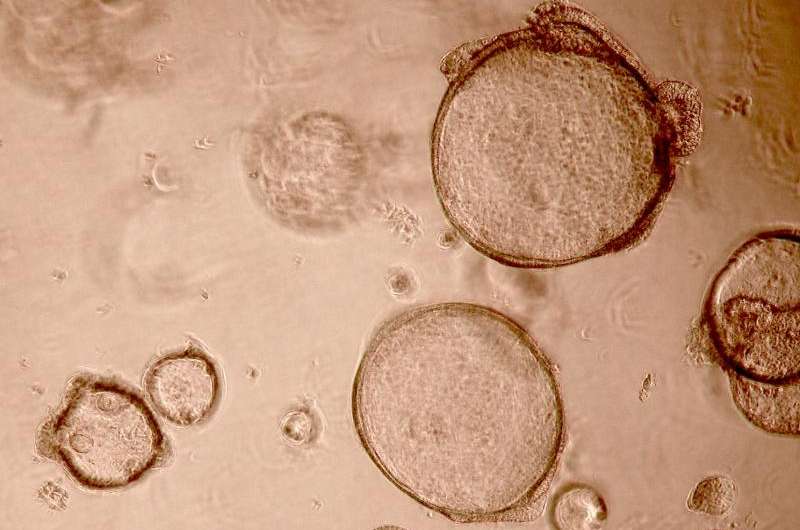Using intestinal organoids to study salmonella

One of the main causes of food poisoning is Salmonella enterica. This bacterium infects cells in the intestinal epithelium that lines our gut, leading to painful stomach cramps, diarrhoea and fever. One major difficulty in studying Salmonella infection is that you can't easily study it in people's intestines, and recreating the intestinal epithelium in a lab setting has been notoriously tricky. However, newly developed intestinal organoids are starting to provide a solution.
Intestinal organoids are little balls of intestinal epithelium, composed of a range of intestinal cell types surrounding a hollow lumen. The organoids act as a bridge between in vivo and in vitro systems.
The intestinal epithelium is an extremely important part of the immune system, with a complex structure and range of cell types. It acts as the dividing barrier between the space inside the gut tube, called the intestinal lumen, and the underlying gut tissue.
I have been generating intestinal human organoids (iHOs) from human induced pluripotent stem cells (hIPSCs). Using a protocol established by our collaborators Ludovic Vallier and his team at the Anne McLaren Laboratory for Regenerative Medicine, I take these stem cells and expose them to different chemical signals. This drives changes in gene expression, which pushes the hIPSCs to change into more specialised cells, in a process known as differentiation. The cells change first into endoderm, and then into hindgut.
To grow the balls, I place this hindgut into a pro-intestinal culture system, with a supporting Matrigel matrix. Growth factors that promote intestinal differentiation and proliferation are added to the media and, after a few weeks, little spheroids start to form.
These balls of cells are self-sustaining and can be grown for long periods of time. They take a while to mature and form structures recognisable as adult cells but, after a few months of intensive culturing, I get intestinal human organoids that are ready to work with. They can then be used as an infection model for enteric pathogens such as Salmonella.
Salmonella enterica serovar Typhimurium causes a self-limiting gastroenteritis in healthy individuals. We wanted to use intestinal human organoids to show the early interactions between S. Typhimurium and the organoids generated from a representative hIPSC-line called A1ATD-1.
Firstly, we had to ensure that the organoids contained different cell types normally found in the intestinal tract, such as Goblet cells and Paneth cells. Specific cell type markers were detected with RT-qPCR, and immunostaining showed the localisation of these markers within different groups of cells. Using transmission electron microscopy we could see clear polarisation of the cells, microvilli and tight junctions, confirming we were growing organoids that displayed characteristics of human intestinal epithelium.
S. Typhimurium would normally interact with the epithelial cells at the luminal side. The bacteria therefore needed to be delivered directly into the luminal cavity of the organoids; the centre of the sphere. This required multiple microinjections of the bacteria into the iHOs before we could collect enough RNA for RNA-Sequencing. After sequencing, we saw previously well-described responses to S. Typhimurium such as up-regulation of proinflammatory cytokines. However, genes such as BIRC3 and IL-20, whose role in Salmonella infection is not well understood, were also flagged. Interestingly, BIRC3 protein is also expressed in enteroendocrine cells, which may shed light on their role in response to intestinal infection.
Many people here at the Sanger Institute are generating human induced pluripotent stem cells so we have a large pool of genotypes to select from. We can therefore utilise our iHO system to help understand how the host genotype can alter the response of the host intestinal epithelial cells. This is a really exciting prospect as this response is crucial to the outcome of an infection, and this work provides support for using iHOs as a tool to study host-pathogen interactions at the intestinal interface.
More information: Jessica L. Forbester et al. Interaction of Salmonella enterica Serovar Typhimurium with Intestinal Organoids Derived from Human Induced Pluripotent Stem Cells, Infection and Immunity (2015). DOI: 10.1128/IAI.00161-15
R.F. Hannan et al. Generation of Multipotent Foregut Stem Cells from Human Pluripotent Stem Cells, Stem Cell Reports (2013). DOI: 10.1016/j.stemcr.2013.09.003


















